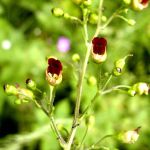| Common Name: |
Common Figwort |
| Botanical Name: |
Scrophularia nodosa |
| Genus: |
Scrophularia |
| Family: |
Scrophulariaceae |
| Native Location: |
Europe |
| Cultivation: |
Moist to wet soil in sun or partial shade. Plants may be damaged by larvae of the figwort weevil. |
| Propagation: |
By seed sown in autumn or spring; by division in spring; by basal cuttings in spring; by softwood cuttings in summer. |
| Harvest: |
Roots (S. ningpoensis) are lifted in autumn and dried for use in decoctions. Plants (S. nodosa) are cut when flowering and dried for use in infusions, liquid extracts, ointments, poultices, and tinctures. |
| Height: |
40cm-1.2m (16-48in) |
| Width: |
15-38cm (6-15in) |
| Hardiness: |
Z6-8 |
| Parts Used: |
Whole plant |
| Properties: |
A diuretic, alterative herb that is mildly laxative, relieves pain, and stimulates the liver, heart, and circulation. |
| Medicinal Uses: |
Internally for chronic skin diseases (such as eczema, psoriasis, pruritis), mastitis, swollen lymph nodes, and poor circulation. Externally for skin diseases (including fungal infections), wounds, burns, ulcers, and skin inflammations. Combines well with Rumex crispus (See, Curled Dock) for skin diseases. |
| Warning: |
Contraindicated for heart conditions. |
| Bibliography: |
Encyclopedia of Herbs by Deni Brown Copyright © 1995, 2001 Dorling Kindersley Limites. Pg 364
|

